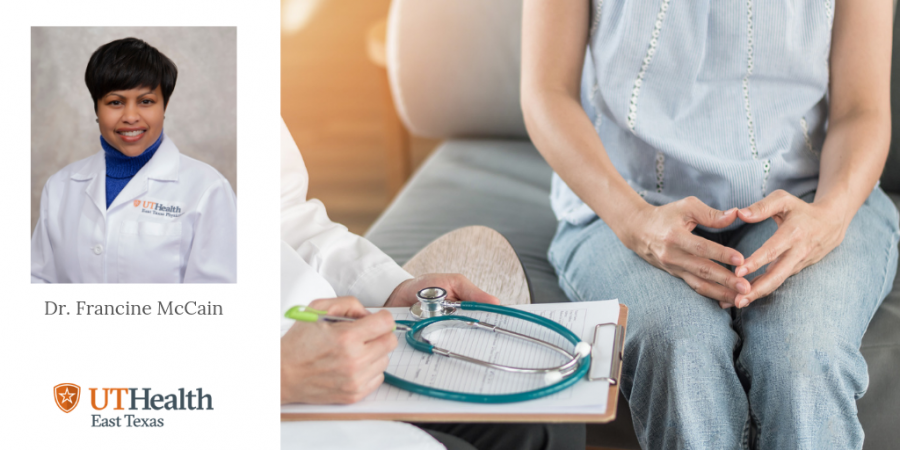
Endometriosis is a condition that affects millions of women, often causing extreme pain and, in some cases, infertility. Even though this serious condition is fairly common, it is often difficult to diagnose, leaving many women suffering for years.
Dr. Francine McCain, board-certified OB-GYN, shares more information on how to diagnose and treat endometriosis.
A Painful Disorder
Endometriosis is an often painful disorder in which tissue that normally lines the inside of your uterus grows outside your uterus. Endometriosis most commonly involves your ovaries, fallopian tubes and the tissue lining your pelvis. Rarely, endometrial tissue may spread beyond pelvic organs.
With endometriosis, displaced endometrial tissue continues to act as it normally would — it thickens, breaks down and bleeds with each menstrual cycle. Because this displaced tissue has no way to exit your body, it becomes trapped. When endometriosis involves the ovaries, cysts called endometriomas may form. Surrounding tissue can become irritated, eventually developing scar tissue and adhesions — abnormal bands of fibrous tissue that can cause pelvic tissues and organs to stick to each other.
Endometriosis can cause pain — sometimes severe — especially during your period.
Difficult to Diagnose
The diagnosis of endometriosis begins with the patient’s history and a physical exam. Endometriosis should be in the differential diagnosis of a women who presents with pain and infertility. Palpation of the pelvic structures can aid in the diagnosis, but it is essentially a diagnosis of exclusion—that is to say other causes for the patient’s symptoms are usually ruled out before a presumptive diagnosis is made. Ultimately, the diagnosis can only be confirmed surgically by visualization or biopsy. This is usually achieved by placing a camera into the abdomen during a procedure called a laparoscopy.
The main symptom of endometriosis is pain, making it a difficult condition to diagnose because symptoms may often be vague. Endometriosis is particularly difficult to diagnose because it can have many different clinical presentations. In addition, some women may not even experience pain (asymptomatic). It’s somewhat of a paradox with endometriosis that those with the largest amount of endometrial implants have the least amount of pain. In these women, their endometriosis may be found incidentally when getting a procedure for a different reason or found only due to the complaint of infertility.
The pain associated with endometriosis can spread around the pelvis or be localized. Because of the ectopic (outside the uterus) nature of endometriosis, it can be found almost anywhere in the body, sometimes causing symptoms that may lead one off the track of endometriosis. Also, it is not well seen on radiological studies. So, whereas something like an acute appendicitis can have a very specific age range, clinical presentation, signs and radiologic findings – endometriosis does not.
What to Share with Your Doctor
Since endometriosis is hard to diagnose, it’s a good idea to gather information before your appointment. Logging your pain experiences and tracking your cycles for 2-3 months can greatly help your doctor. Note when you have pain, how long it lasts, where on your body it occurs, the type of pain (e.g. sharp, dull, etc.) and the circumstances around the pain. It’s especially important to note if it is occurring just before or during your cycle. Endometriosis is notorious for causing pain outside of a women’s menstrual cycle.
As with any doctor’s visit it’s important to be honest. The symptoms of endometriosis can be difficult to discuss and sometimes embarrassing. For instance, a woman may come to the office to discuss painful cycles and infertility but will not mention that she has pain with intercourse, or pain with defecation (dyschezia), or localized pain in the rectum.
Medical Treatment or Surgical Treatment
The treatment for endometriosis basically falls into two categories: medical or surgical. The medical treatment addresses the pain aspects (dysmenorrhea, dyspareunia, and pelvic pain) of endometriosis. Possible treatments include pain medication to relieve cramps during menstruation and/or hormone treatment which can also reduce or eliminate pain during menstruation.
Surgical treatments include the removal or ablation of abnormalities during laparoscopy, which may help with pain. Surgery may also help restore fertility. If you are not planning on having any more children, other surgical treatments may be available and should be discussed with your physician.
Next Steps
Talk to your doctor if you are experiencing any of these symptoms, making sure to be as specific and honest as possible. To find a new doctor, including an OB-GYN, please call 903-596-DOCS to set up an appointment.
Francine McCain, MD, FACOG, is a board-certified obstetrician and gynecologist who practices at UT Health East Texas Physicians in Athens. “I am committed to the idea of a woman’s right to accessible and appropriate healthcare. I am devoted to building meaningful relationships with the women in my community, while leading them to better physical wellness.”
Dr. McCain became a physician because she was interested in the anatomy and physiology of the human body. “I chose obstetrics and gynecology because I wanted to focus on the health and well-being of female adolescents and women. For a specialty, it’s extremely diverse with primary care at its core.”

